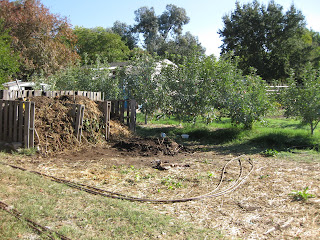
There's a slight chill in the morning air. Autumn has finally arrived in Northern California, bringing high temperatures of 70's to 80's. Suddenly I find myself craving kale and butternut squash, soups and stews.
I bought a butternut squash at a farmer's market this week, because it simply seemed like the thing to do. As I contemplated the possibilities, I decided I wanted something heartier than butternut squash soup, although I also have
a good recipe for that classic autumn dish as well.
I thought of one of my favorite dishes at a certain Italian restaurant, a tender ravioli filled with butternut squash in a creamy sauce with fried sage.
Not being ambitious enough to hand roll my own pasta, I settled upon a recipe that used farfalle but the same classic flavors of squash and sage, along with pine nuts for a crunch. We used sage from our yard, which is happily thriving now that it can sink its roots into actual earth, and two small Walla Walla onions still hanging in there from the garden.
The final product was addictive - sweet, salty, herbaceous, it had all of my favorite elements from the more complicated ravioli dish, but with a fraction of the effort. I declare it the perfect hearty supper for a cool fall night.
Pasta Pan-Fried with Butternut Squash, Fried Sage, and Pine Nuts
From The Kitchn
1 medium butternut squash
1 small sweet onion, peeled and diced
3 cloves garlic, minced
Olive oil
Salt and pepper
1/2 cup fresh sage leaves
1 pound farfalle pasta
3/4 cup pine nuts, toasted
4 ounces high quality Parmesan, shredded or shaved (about a cup total)
Heat the oven to 375°. Cut the butternut squash in half and scoop out the strings and seeds the middle cavity. Flip the squash halves upside down and peel them. (Note: The raw squash rind can irritate your hands. If they start to itch or tingle, wear gloves.) Cut the squash into 1-inch cubes. Toss with the onion, garlic, a drizzle of olive oil and salt and pepper. Mince about half of the fresh sage leaves and also toss with the squash.
Spread the squash mixture in a thin layer on a large baking sheet and roast for about 40 minutes or until the squash is soft.
Heat salted pasta water to boiling and cook the farfalle until al dente. Drain and set aside. As the squash finishes roasting, heat about two tablespoons of olive oil in a large high-sided sauté pan. The oil is ready when it pops and sputters. (Don't let it start smoking.) Drop in the rest of the sage leaves and fry for about a minute, or until they begin to just shrivel up.
Remove with a slotted spoon and salt lightly. Crush with the back of a spoon. Add half the pasta to the pan, along with half the roasted squash mixture. Crumble in half the sage. Cook, stirring frequently, for five minutes or until the pasta is heated through and getting crispy on some of the edges. Add the pine nuts and cook for another minute. Stir in half the cheese and serve. Serves 4 generously.
(Repeat the last step with the rest of the ingredients. We split it into two because none of our pans are big enough to accommodate the entire recipe. It's very important that you not crowd the pan too much - you want the pasta to really pan-fry, not just steam up.)
 The bad news:
The bad news: We still have a long ways to go, but just think - bags and bags of free walnuts to last a year! (That's how long they keep in the freezer.) I'm a big fan of adding nuts to all sorts of baked goods; cakes, cookies, and crisps are all better with some toasted nuts. Here's to free food!
We still have a long ways to go, but just think - bags and bags of free walnuts to last a year! (That's how long they keep in the freezer.) I'm a big fan of adding nuts to all sorts of baked goods; cakes, cookies, and crisps are all better with some toasted nuts. Here's to free food!







